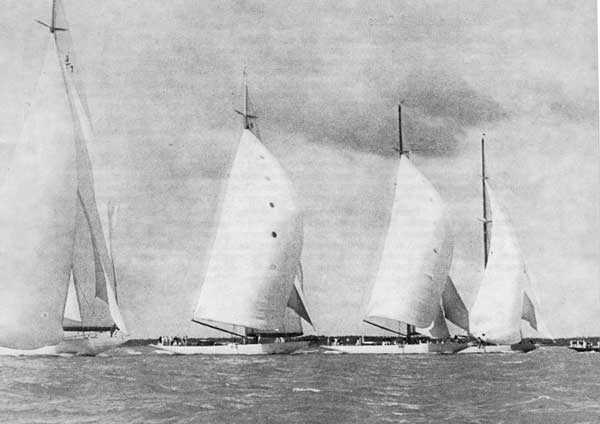
(text)
Between the Wars:
Club Classes and Racing
The Restricted West Solent Class: 32 ft 6 in x 7 ft 6 in x
5 ft 1 1/2 in, introduced in 1924 by the Commodore, Major Cyril
Potter. The popularity of the class was largely
instrumental in the success of the Club. Six-ton sloops,
they were designed by HG May and built by his yard, the Berthon
Boat Company.
"... Each boat was manned by a paid "Skipper" who had a
considerable say in all matters concerning the conduct of every
race, though (at least in theory) his hand never touched the
tiller.
"... A novel feature of all those West Solents was the fact that
they were the first class-racing boats to be equipped with the
new-fangled sanitary apparatus known as "the Admiral" (Blake, of
course). This essentially sensible fixture (made more
necessary by the fact that at least two of the yachts were owned
by ladies) was regarded by the racing fraternity as the greatest
joke since the invention of the internal-combustion engine.
It was no uncommon sight, when the Class visited Cowes and other
locations away from Lymington, for the numerous paid hands (and
there were plenty among the twelve-, eight- and six- metres) to
gather on their respective decks to greet these "sissy"
newcomers with significant gestures of the art of chain-pulling"
The 'X'.O.D., Lymington Division:
The third oldest division of its class, it was born in 1927 with eight
boats, its first captain being Admiral Sir Sackville Garden of the Gallipoli
tragedy. Three of the originals, X. 18, X.20 and X.23 are now back in
Lymington, X.20 still bearing her original name. The Division was disbanded
in 1931 and did not reform until the Second World War. The 'X' Class were,
and still are, popular racing boats if you don't mind a thorough wetting in
a Solent lop.
An ex-member recalls: "Of the 'X' Class, I remember discussing with the
Captain of the Itchenor contingent their proclivity for drenching their
crews. It was at a cocktail party. 'Wet? 'he exclaimed; 'they're as dry as a
bone.' He then fell backwards down a companion way, no doubt struck down
from On High (or by the strength of the Martinis). Fortunately he was
unhurt.
The Thirties and the ‘L’ Class:
"... As the membership of the Club increased, a demand for a less
plutocratic type of racing yacht and one more suitable for picnicking, as
well as for racing, was met by the design of the Lymington 'L' Class by J.
Laurent Giles. These were compact four-tonners fitted with small motors and
they effectively supplanted the dying West Solent Class. Few, if any,
carried a paid Skipper though the competition in the races seemed to become
even hotter than previously, and resulted in at least one cause celebre
which was only prevented from becoming a public scandal by the intervention
of
Herr Hitler."
The Coronation Class:
"... It was partly owing to the unpopularity of some of the methods employed
by the 'L' Class owners that an attempt was made to form in 1937 yet another
and less expensive class of cabin-boat, called in honour of the new
Sovereign, 'the Coronation Class'. They were built at Dunoon on the Clyde
and cost, complete with the barest essentials, no more than £75, plus a
fiver delivery charge. The introduction of these cheap little vessels was
far from popular. Members of the established classes combined to attack the
qualities of the Coronations in a manner resembling that of chickens
resenting the intrusions of a newcomer. The 'pecks' were pretty savage.
These boats were (it was said openly) either crank or stiff, and appeared to
have been hastily constructed from old biscuit boxes. Fortunately, the
general opinion summed up, 'the boats would soon fall to pieces'. Some
twenty years later these ugly ducklings were to be seen in Cherbourg and
Biscay, though as a class they did not survive. Their place was filled by
the evergreen 'X' Class."
The Gauntlets:
No history of the Club could be complete without
reference to the creation by the Berthon Boat Company of the 'Gauntlet'
series of cruising-cum-ocean" racing of twelve, fourteen, or
even
larger tonnage. All these fine weatherly vessels were built in Lymington,
though curiously enough they gained little favour with the general run of
deep-water sailors in the Club. In fact, until after the conclusion of the
Second World War, these same deep-water members regarded themselves as a
class apart from those who were content to make use of the comparatively
sheltered waters of the Solent and, almost without exception, made no active
contribution to local sailing activities, ostentatiously taking their ships
elsewhere during Regatta Weeks and other Club functions.
The Montagu Sharpie:
16' x 6' beam/ carvel-built:
Depicted in the painting in the corner of the bar, the Montagu Sharpie was
adopted by the Club in 1938. It was thus named after the late Lord Montagu
because Elkins of Christchurch had built a small number for the Beaulieu
River Sailing Club. In 1949, like the Pram, the class gave way to the
Firefly.
On Whit Monday, 17 May. 1948, the School of Infantry's Sharpie, Micawber,
was run down by Farringford. One of the Sharpie's crew. Major G. Rickman,
was caught in the ferry's revolving paddle wheel. Miss P. Clarke, the other
crew, could not swim. Both survived.

The Big Cutters and the Js:
Britannia, Astra. Shamrock V, Westward. White Heather. Velsheda, Yankee,
Endeavour I and II and Candida, owned by H. Andreae of the L.Y.C. What
memories these names evoke.
Though no J sailed up the Lymington River (they drew 14 feet), they would
use the L.Y.C. start line between two naval cutters. The Js raced in the
Lymington Regatta on Wednesday; and, in the Yarmouth Regatta on the Thursday
and Friday, in spite of arguments with Black Rock.
The Class (1926-1935) was followed by the 12-metres, for by 1935 the cost of
racing a J had become astronomical.